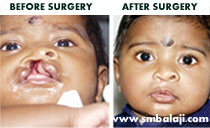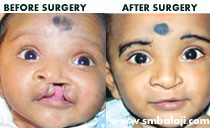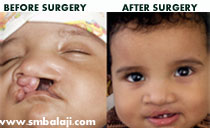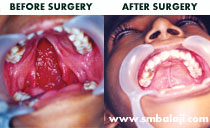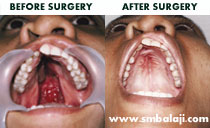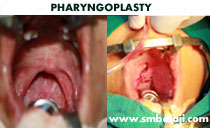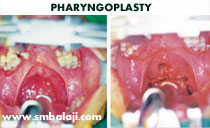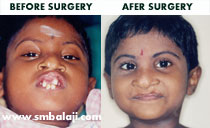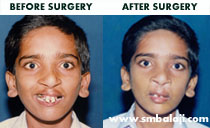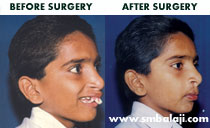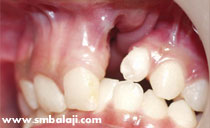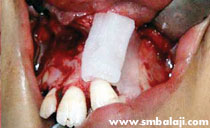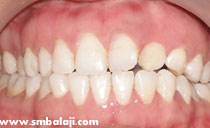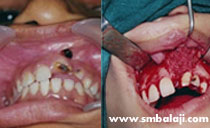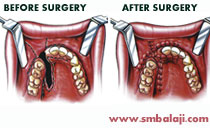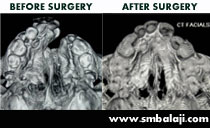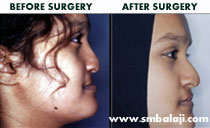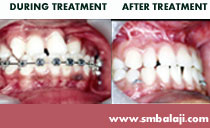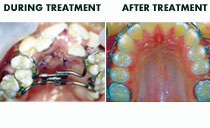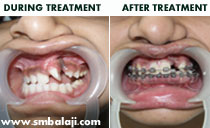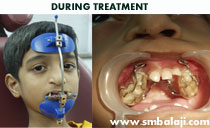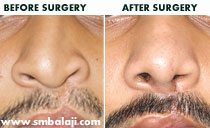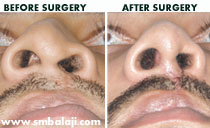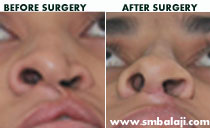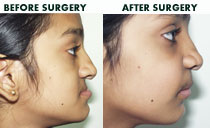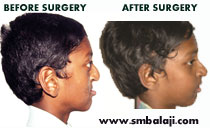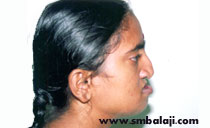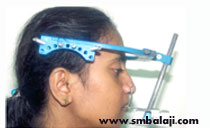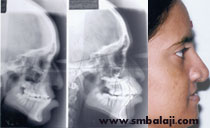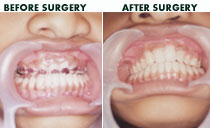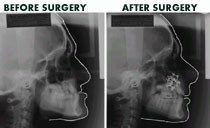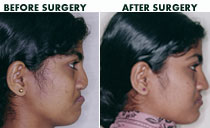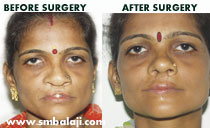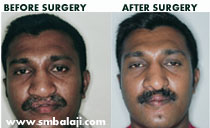Treatment for cleft lip and cleft palate
Primary lip repair
The main concern is creating a lip seal to enable the child to suck milk. But before the child is healthy enough to undergo the surgery, a feeding plate may be given to prevent aspiration of milk from the mouth to the nose, through the gap in the palate (roof of the mouth). Specially designed feeding bottles may also be used to help in feeding.
The primary repair of the cleft lip is done at the age of 3 months. It is important to recreate the natural shape and muscle of the upper lip. Prof. Balaji excels at a scarless surgical repair of the cleft lip.
Palate Repair
Balaji Dental and Craniofacial Hospital is renowned for its successful outcomes of cleft palate surgery in India. The cleft palate repair surgery is performed at about 9 months of age. Early repair is done to close the gap in the roof of the mouth creating a barrier between the mouth and the nose. Since the palate plays a key role in speech, voice and phonation the cleft hard palate should be closed as early as possible. This surgery is very essential for normal speech to develop.
Pharyngoplasty
Because of the nature of the problem, the child with a cleft is more at risk of having a speech and/or language problem, and close attention must be given to the child’s speech development. Most problems can, however, be resolved with speech and language therapy.
Cleft children commonly have Velopharyngeal incompetency (VPI). In this, the soft palate and posterior wall of the throat fails to separate the mouth from the nose during speech. This leads to a nasal twang in their voice. Their speech may be difficult to understand due to escape of air through the nose during speech. To help treat this problem, a surgery called Pharyngoplasty may be needed. In this procedure, soft tissues in the throat are surgically rearranged to treat VPI.
Pharyngoplasty combined with speech therapy helps the child to speak well.
Premaxillary set back
Premaxillary protrusion (protruding anteriormost portion of the upper jaw) is a characteristic feature of infants with complete bilateral cleft lip and palate. The surgical procedure premaxillary setback is designed to facilitate lip repair and to fit the premaxilla into the maxillary arch to achieve an idealized arch form at an early age. This is usually done in the pre-school age to enhance appearance.
Alveolar bone cleft closure
Closure of the cleft in the upper alveolar bone (tooth bearing region of jaw) is required to provide a solid surface for the permanent teeth to erupt into.
Conventionally, to close the gap in the upper alveolus a small amount of bone is taken from the child’s hip bone and placed in the region of the cleft in the upper jaw to close the gap. This incurs an additional surgery at the hip bone, increases blood loss and pain. More importantly, it results in a scar in the hip region. Nevertheless, there are no major complications.
Alveolar bone cleft closure using rhBMP-2
Alveolar bone cleft closure using Bone Graft
For the first time in India, since 2008, to avoid bone grafting from the hip, a recent and revolutionary invent, the miracle protein recombinant human bone morphogenetic protein-2 (rhBMP-2) is used successfully at Balaji Dental and Craniofacial Hospital.
This synthetic bone material is placed in the site which stimulates the body’s own cells to rapidly produce new bone thus promoting bone growth. Following this, normal teeth eruption and teeth alignment can be achieved.
With this, an additional surgery to harvest bone and subsequent scarring is prevented. Post-surgery recovery is faster and hospital stay is minimum. rhBMP-2 now ensures superior results to the conventional alveolar bone grafting technique by allowing cleft closure at a more younger age of 3-4 years than waiting till 7-8 years.
Cleft Orthodontics
A cleft can produce a variety of dental problems. The cleft displaces the teeth; teeth erupt in abnormal positions, disturbing their alignment.
Since children with clefts may have special problems related to missing, malformed, or malpositioned teeth, they require early evaluation by an orthodontist who is familiar with the needs of the child with a cleft.
Alveolar bone cleft closure using Bone Graft
Irregular teeth are also difficult to maintain. Teeth alignment is essential to maintain good oral hygiene. Patients with cleft lip and palate can suffer from deformed upper jaw and skeletal growth retardation. Jaw and teeth irregularities also affect speech. Continuous assessment and correction of jaw growth and dental development is required.
Nose Correction
Dr. S. M. Balaji, has mastered the art of cleft nose correction or cleft rhinoplasty and the surgical outcomes speak volumes about the deftness of this surgeon. He has performed more than twenty five thousand surgeries till date and is active in research and scientific advancement. His surgical techniques have been published in several International Research Journals. His research on cleft nose surgery has received the “the best research paper” award at the “International Conference on Cleft Lip and Palate” that was held in Zurich. Switzerland, and at the “International Conference of Maxillofacial Surgeons,” held at Surabaya, Indonesia.
As bone growth is retarded due to cleft, the nasal bones are also underdeveloped giving the nose a tilted appearance. The bridge of the nose and nose tip may be deviated to one side giving an asymmetrical appearance. Bony abnormalities may occur along the floor of the nose. This distortion in shape also affects breathing and nasal airflow.
Rhinoplasty or nose correction surgery aims at restoring normal form and function. These surgeries are approached from inside the nose and from deep below the upper lip so as to avoid any unsightly scars.
Distraction Osteogenesis
Cleft decreases the growth potential of the jaws. As a result, the upper jaw remains small while the whole face grows. Depending upon the degree of cleft , the severity of the jaw defect can range from slight depression to a dish face appearance.
In Distraction Osteogenesis, the jaw bone is cut and the distractor device is fitted between the cut ends. The screw connected to the device is gradually rotated. The rotation of the screw brings about a slow separation between the cut bone segments. New bone is formed to fill in the gap and ultimately the bone is lengthened.
Orthognathic Surgery
Corrective jaw surgery or orthognathic surgery may be required to correct disparity between upper and lower jaw, bring the jaws into proper alignment and to enhance the facial profile.
Secondary corrections
It may take more than one surgery to achieve the best possible appearance and function of the child’s lip and palate. This is especially true because as the child grows, the scars from previous surgeries may not grow and stretch in the same way as skin without any scars. As the child’s face develops, there may be a time when it would be appropriate and beneficial to have a “touch up” surgery to improve the appearance of the lip.
Abbe-flap surgery: After initial surgery, the scar on the upper lip thickens radically resulting in a thin upper lip. Abbe flap surgery may be done to correct this. A portion of the normal lower lip is taken, rotated across the mouth and placed into the defect in the upper lip maintaining blood supply. After blood supply is established and the blood vessel can be cut, the flap is divided.

